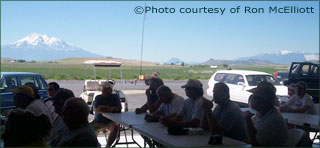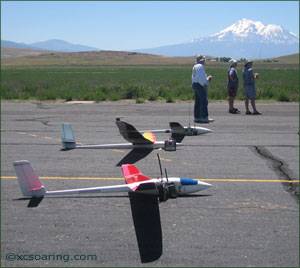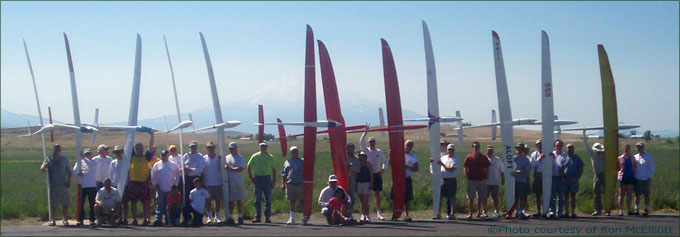What can I say... once again, this event was outstanding!
When Marcela and I arrived Thursday afternoon under a blue and cloudless sky,
the host Dean Gradwell and his helpers Bob, Ron, Roger, et al. had the hangar
ready and the winches set up; in fact, people had been flying all afternoon.
Ten teams participated in this 3-day event, including Team ALOFT from North
Carolina flying an autonomous sailplane based on the SBXC airframe (more
on that later).
 The blue and cloudless sky was with us all three days. Such a sky often
signals poor conditions, but at least the wind forecast looked good:
mostly calm for the entire weekend. There is no point in fretting over
the weather, and after all, this event is called Montague Cross Country
Challenge, not Cake-walk. The blue and cloudless sky was with us all three days. Such a sky often
signals poor conditions, but at least the wind forecast looked good:
mostly calm for the entire weekend. There is no point in fretting over
the weather, and after all, this event is called Montague Cross Country
Challenge, not Cake-walk.
On Friday we flew a speed task with a 2-hour minimum flying time and
open maximum, where speed is determined by dividing the distance flown
by the flying time. As part of the task, every team had to first complete
a prescribed sequence of turn points: from the start gate, 2.3 miles
west to the course's central 13.6-mile loop; counter-clockwise around
the loop; then go north 6 miles to the northern-most turn point and return
to the loop; after that the course was open.
The Challenge part became obvious after launch, when teams could climb
quite easily to about 1500 feet, where the thermals either fizzled out
or disappeared. Several teams were bumping around under that invisible
ceiling for quite a while, until finally the thermals slowly started
inching higher and the teams got on course. Even though we never could
get to our comfort altitude, the conditions were better than expected.
There were no booming thermals but there also was little severe sink;
at times, we could cruise along in 0/0 lift/sink conditions; the Germans
call this "Nullschieber" (pronounced "noollsheeber").
John Ellias won that day with Jim Rolle nipping at his heels; they averaged
17.26 and 16.73 mph respectively.
 Team ALOFT finished in the middle of the pack with an average of 12.50
mph. A quick word about this young team and their effort: Adam, Chris,
and Dan traveled from North Carolina to test their autonomous soarer
in real-world conditions. The performance was astonishing, and I believe
it even exceeded their own expectations! Essentially, they have loaded
a SBXC with electronics, for which they wrote proprietary software,
which in turn makes the plane fly autonomously along GPS way points setup
on a laptop computer from the ground. Team ALOFT finished in the middle of the pack with an average of 12.50
mph. A quick word about this young team and their effort: Adam, Chris,
and Dan traveled from North Carolina to test their autonomous soarer
in real-world conditions. The performance was astonishing, and I believe
it even exceeded their own expectations! Essentially, they have loaded
a SBXC with electronics, for which they wrote proprietary software,
which in turn makes the plane fly autonomously along GPS way points setup
on a laptop computer from the ground.
That sounds simple enough, but this glider doesn't just fly a course:
if it gets below a preset altitude, it enters thermal mode and searches
for, finds, and climbs in thermals all on its own, until it decides it's
high enough to get back on course. Read that last sentence again and
think about it: this is an unpowered aircraft which finds thermals and
uses them to traverse a set course!
In fact, in the three days of competition, the human pilot (Adam) only
launched and landed the glider; the actual tasks, including searching,
thermaling, and cruising were flown autonomously. For me, a highlight
of the event was seeing these three happily smiling guys return to the
field like spectators with no one looking up or holding a transmitter.
They'd get out of the car and point toward the arriving plane: "here
it is..."
On Saturday, in tough conditions, their glider flew 39.44 miles on its
own, which again placed them in the middle of the pack. -- Saturday's
task was open distance, which means teams are scored only on the distance
they fly along the course, not on speed. Conditions were weak, and I
don't remember our team (John Ellias) ever having to be grateful for
such wimpy thermals or pushing on from such low altitudes. We labored
along the course at a glacial speed, and managed 48.46 miles. David Portwood
won that day with 53.76 miles flown, a great achievement on that slow,
cloudless day. After such a long and hot day in the car, the fabulous
Saturday-night barbecue really is something to look forward to...
 Sunday's task has become my favorite: a speed lap around the central
loop. To illustrate the different conditions, last year, Greg Norsworthy
and his team "Mister Bungle" did this in 29 minutes and 40
seconds and set a new course record. This year, our team took 30 minutes
longer and still won. Last year, Mister Bungle started at over 1700 meters
and cruised around the course without stopping. This year, we never even
reached 700 meters, and we had to stop often. Sunday's task has become my favorite: a speed lap around the central
loop. To illustrate the different conditions, last year, Greg Norsworthy
and his team "Mister Bungle" did this in 29 minutes and 40
seconds and set a new course record. This year, our team took 30 minutes
longer and still won. Last year, Mister Bungle started at over 1700 meters
and cruised around the course without stopping. This year, we never even
reached 700 meters, and we had to stop often.
This was also the flight where a bird helped us significantly: We desperately
needed more altitude to make it across Montague, but the vario was moaning
as John was "nullschiebering" at about 200 feet all over the
quarry just south of town; the plane wouldn't climb, and this is a notoriously
bad place to land. We needed help, and suddenly I saw a bald eagle circling
only about 100 feet in front of and above the car. John quickly joined
him, and the two happily climbed out together. The thermal was drifting
behind us and I had to back up the car a ways, but is was worth it: the
plane got high enough to finish the task. By the way, Team ALOFT's thermaling
robot took only 12 minutes longer than we and finished fourth!
The Montague Cross Country Challenge must be the premier RC cross-country
soaring event in the country, possibly anywhere. This was the 11th such
annual event -- I have participated in seven -- and every time my appreciation
grows for Dean's generous hosting and organization, the beautiful setting,
and the challenge of the tasks; in that order!
Next year's event will be June 12-14, and believe me when I say that it
is one of the hardest things to give up for Marcela and I, as we're moving
to Colombia.
|


 The blue and cloudless sky was with us all three days. Such a sky often
signals poor conditions, but at least the wind forecast looked good:
mostly calm for the entire weekend. There is no point in fretting over
the weather, and after all, this event is called Montague Cross Country
Challenge, not Cake-walk.
The blue and cloudless sky was with us all three days. Such a sky often
signals poor conditions, but at least the wind forecast looked good:
mostly calm for the entire weekend. There is no point in fretting over
the weather, and after all, this event is called Montague Cross Country
Challenge, not Cake-walk.  Team ALOFT finished in the middle of the pack with an average of 12.50
mph. A quick word about this young team and their effort: Adam, Chris,
and Dan traveled from North Carolina to test their autonomous soarer
in real-world conditions. The performance was astonishing, and I believe
it even exceeded their own expectations! Essentially, they have loaded
a SBXC with electronics, for which they wrote proprietary software,
which in turn makes the plane fly autonomously along GPS way points setup
on a laptop computer from the ground.
Team ALOFT finished in the middle of the pack with an average of 12.50
mph. A quick word about this young team and their effort: Adam, Chris,
and Dan traveled from North Carolina to test their autonomous soarer
in real-world conditions. The performance was astonishing, and I believe
it even exceeded their own expectations! Essentially, they have loaded
a SBXC with electronics, for which they wrote proprietary software,
which in turn makes the plane fly autonomously along GPS way points setup
on a laptop computer from the ground.  Sunday's task has become my favorite: a speed lap around the central
loop. To illustrate the different conditions, last year, Greg Norsworthy
and his team "Mister Bungle" did this in 29 minutes and 40
seconds and set a new course record. This year, our team took 30 minutes
longer and still won. Last year, Mister Bungle started at over 1700 meters
and cruised around the course without stopping. This year, we never even
reached 700 meters, and we had to stop often.
Sunday's task has become my favorite: a speed lap around the central
loop. To illustrate the different conditions, last year, Greg Norsworthy
and his team "Mister Bungle" did this in 29 minutes and 40
seconds and set a new course record. This year, our team took 30 minutes
longer and still won. Last year, Mister Bungle started at over 1700 meters
and cruised around the course without stopping. This year, we never even
reached 700 meters, and we had to stop often. 